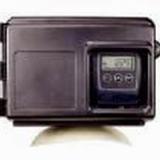
Uranium Removal

| All Fleck 2510 Uranium Removal Systems have the following components: (unless otherwise specified) |
|
|
|
|
|
|
| IMPORTANT INFORMATION FOR THE CONSUMER (ResinTech Uranium Technical Data Sheet) |
| The ResinTech SSBG2 HP anion resin that we market, should be regenerated with salt, to minimize the amount of uranium that builds up on the resin. Under normal circumstances, you should be able to operate one of these units for several years, before the resin needs to be replaced. Shown below, are the basic regeneration requirements. In the end, the amount of uranium on the resin should be under the low level waste levels and can be disposed of as described below. Regeneration is a great option, but some states don't like the brine discharge and reintroduction of the uranium to the ground water supply. If they allow it, this is the most economical long term approach. |
| Regeneration |
| In order to regenerate the uranyl carbonate it is important that the concentration of the regenerant at the resin bed be sufficiently high to reverse or reduce the relative affinities to acceptable levels and to use enough regenerant and contact time. Sodium chloride is the most common regenerant. Concentration above 10% NaCl, at regenerant levels of 14 to 15 lbs. per cu. ft. is sufficient to insure better than 90% uranium removal through the operating cycle. This dosage will elute at least 50% of the collected uranium from the resin. Leakage will remain low through the service cycles even without complete regeneration because of the very high selectivity during the service cycle. Leakages are essentially nil for regeneration levels of 15 lbs. of sodium chloride per cu. ft. at concentrations of 10% or higher with minimum contact time of at least 10 minutes during regeneration. The chloride ion is the most effective ion for regeneration of uranium of those commonly found in potable water. Neutral salts, (sodium chloride by far the most common) are usually preferred because of environmental and materials of construction considerations. |
| Safety & Handling |
| Regenerant waste from the uranium removal system is a concentrated form of the uranium and must be disposed of properly. For the homeowner, the spent solution is usually discharged the same way softener brine is discharged, the net amount of uranium reaching the disposal point is the same whether or not a uranium removal unit is in place. It is the homeowners responsibility, to check disposal regulations, for their locale. Disposal of uranium-laden resin must take into account the amount of radioactivity present in the media. The U.S. Department of Transportation regulates the transportation and handling of low level radioactive waste. Uranium is less toxic and so has higher allowable levels than radium. The reported level for uranium is 2,000 picoCuries per gram of media. Service cycles on regenerable units can reach theoretical throughput volumes of 40,000 to 50,000 bed volumes (BV). Consideration must be given to the total amount of uranium collected and the subsequent disposal issues. |


 (0)
(0) 